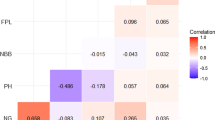Abstract
Thirty progenies of mungbean were produced by crossing 10 true-breeding genotypes with three testers (NM 92, 6601, and their F1) in a Triple Test cross (TTC) fashion and evaluated with parents in the kharif (July-October) and spring/summer (March-June) seasons. The data on parents and F1s were analysed for pod clusters on main stem, pod clusters on branches, node of the first peduncle, nodes on main stem and average internode length to detect epistasis and estimate additive and dominance components of genetic variation. Epistasis was observed for node of the first peduncle and nodes on main stem in the kharif season. Partitioning of total epistasis revealed that both additive × additive (i type), and additive × dominance, and dominance × dominance (j and l types) interactions were significant with prevalent influence of i type interactions on these traits. Both additive and dominance components of genetic variation were significant for all those traits not significantly influenced by epistasis in either or both seasons. The additive component was predominant for pod clusters on main stem, pod clusters on branches and average internode length in the kharif season, and for the node of the first peduncle and nodes on main stem in spring/summer season whereas dominance component was important for pod clusters on main stem, pod clusters on branches, and average internode length in spring/summer season. These results suggested that particular generation of segregating population and specific breeding method for selection might be adopted in each season for the improvement of these traits in mungbean.
Similar content being viewed by others
References
Burton, G.W., 1968. Heterosis and heterozygous in pearl millet forage production. Crop Sci 8: 229–230.
Jinks, J.L. & J.M. Perkins, 1970. A general method of detecting additive, dominance, and epistatic components of variations. III. F2 and backcross population. Heredity 25: 419–429.
Jinks, J.L., J.M. Perkins & E.L. Breese, 1969. A general method of detecting additive, dominance and epistatic variation for metrical traits: II. Application to inbred lines. Heredity 24: 45–57.
Kearsey, M.J. & J.L. Jinks, 1968. A general method of detecting additive, dominance and epistatic variation for metrical traits. I. Theory. Heredity 23: 403–409.
Ketata, H., E.L. Smith, L.K. Edwards & R.W. McNew, 1976. Detection of epistatic, additive, and dominance variation in winter wheat. Crop Sci 16: 1–4.
Mukher, M.S., T.S. Sandhu & B.S. Bhullar, 1988. Genetics of quantitative characters in summer mungbean (Vigna raidata (L.) Wilczek Var. radiata). Indian J Genet 48(1): 113–114.
Pawar, I.S., M. Yunus, S. Singh & V.P. Singh, 1994. Detection of additive, dominance, and epistatic variation in wheat using triple test cross method. Indian J Genet 54(3): 275–280.
Poehlman, J.M., 1991. The Mungbean. University of Missouri, Columbia, USA. 343 p.
Pooni, H.S. & J.L. Jinks, 1976. The efficiency and optimal size of triple test cross designs for detecting epistatic variation. Heredity 36(2): 215–227.
Ram, T., 1997. Gene action for certain quantitative characters in greengram (Vigna radiata (L.) Wilczek). Indian J Genet 57(2): 143–148.
Singh, R.K. & B.D. Chaudhary, 1985. Biometrical Methods in Quantitative Genetic Analysis. Kalyani Pub., Ludhiana, New Delhi, Revised Ed.
Singh, S., S. Kumar, I.S. Pawar & I. Singh, 1992. Detection and estimation of additive and dominance components and their interactions with sowing date in the presence and absence of epistasis in wheat. Haryana Agric Univ J Res 22: 165–169.
Srinives, P. & W. Tangbunitivong, 1991. Genetic study of yield and yield components in mungbean (Vigna radiata (L.)Wilczek) grown in dry and wet seasons. J Natl Res Council Thailand 23(1): 1–13.
Thimmappa, A.S., 1987. Genetic analysis of quantitative traits in greengram (Vigna radiata (L.) Wilczek). Mysore J Agric Sci 21(1): 94.
Tickoo, J., L. Grajraj, R. Matho & C. Manji, 1996. Plant type in mungbean (Vigna radiata (L.) Wilczek). In: A.N. Asthana & D.H. Kim (Eds.), Proc Recent Adv in Mungbean Research, Indian Society of Pulses Research, Kanpur, India. pp. 197–213.
Virk, D.S. & J.L. Jinks, 1977. The consequences of using inadequate testers in the simplified triple test cross. Heredity 38: 237–251.
Wilson, N.D., S.T. Merc & N.K. Nayar, 1985. Combining ability in greengram. Indian J Agric Sci 55: 655–670.
Author information
Authors and Affiliations
Rights and permissions
About this article
Cite this article
Khattak, G., Haq, M., Ashraf, M. et al. Triple test cross analysis for some morphological traits in mungbean (Vigna radiata (L.) Wilczek). Euphytica 126, 413–420 (2002). https://doi.org/10.1023/A:1019987620535
Issue Date:
DOI: https://doi.org/10.1023/A:1019987620535




